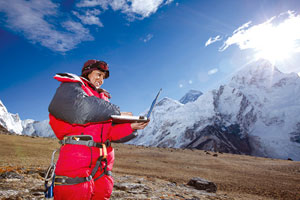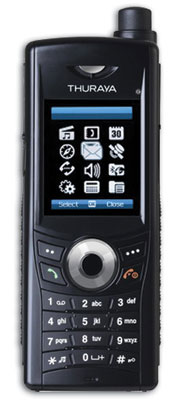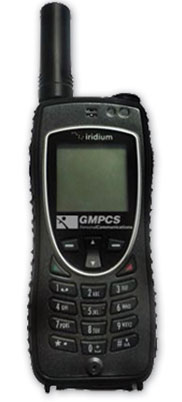 |
Now that the trekking and mountaineering season is about to start, the worry for tour organisers as well as tourists is how to keep in touch while on the trail.
In the past year, Nepal's mobile phone providers have built base stations at the base camp of Mt Everest, and along sections of busy trekking routes. The jury is out on which provider has the best coverage, but phones that take multiple SIM cards of NT, Ncell, and Hello would be the best bet. CDMA phones and modems have more coverage in remote areas, but work mostly in and around the district capitals.
But there are still large parts of remote Nepal that are out of reach of GSM signals, and this includes the increasingly popular Budi Gandaki Trail, Rolwaling, Langtang, and Dhaulagiri. Here the only way to keep in touch will be through satellite phones.
Among satellite phones, there are three choices: Inmarsat, Iridium, and Thuraya. Here, too, people have their favourite phone systems, and all three have their pros and cons in terms of cost, reliability, and signal quality. Most people still choose satellite phones by their looks, and as with human beings, this can be deceiving since beauty is only skin deep.
Thuraya and Inmarsat provide coverage through geo-stationery satellites that orbit the earth 36,000km out in space above the equator so that they are always above the same point on the earth's surface. Iridium, on the other hand, links handsets to a fleet of 66 or so low-orbit satellites only 600km above the earth's surface.
Unlike mobile phones, satellite phones need to be pointed at the satellite and you need to be outdoors-sometimes they don't even work inside tents. Iridium has a shorter time lag, while geo-stationary satellites have up to two seconds lag during conversations.
In terms of coverage, Thuraya specialises in the Asia and north-Africa region, while Inmarsat phones work all over the world although both don't work as well at the poles (which shouldn't affect us here in Nepal). With Iridium, there are always three satellites within range no matter where you are in the world.
 HELLO HOME: Members of a Singaporean women's expedition call home on an Iridium satellite phone from Mt Everest Base Camp in 2009. |
Cost-wise, Iridium phone sets tend to be more expensive, and the subscription and cost per calls are also more. Iridium tends to drop calls more often as it switches satellites, and this adds up the cost of calling.
Iridium, Thuraya, and Inmarsat all have dealers and showrooms in Kathmandu, and most of their customers are trekking and mountaineering groups as well as relief agencies. During the war, however, Maoist guerrillas as well as the security forces were using satellite phones too. There is now also interest from embassies, aid agencies, and Nepali companies which want to prepare for a major earthquake that will throw out all communications, including mobile phones.
"We have to be prepared for an eight magnitude earthquake that is sure to hit Kathmandu someday," says Anudan Jung Rana of the Dubai-based Thuraya dealer, Constellation, in Kathmandu. "It will be critical for coordinating search, rescue, and relief."
Next month, Thuraya is introducing its XT Dual model which can accommodate two SIM cards, one for the satphone, and one for normal mobile service. It has a stronger body and better battery life compared to earlier models. It can also be hooked up to a laptop and used as a satellite modem for Internet.
Since remote trekking areas (or Kathmandu after an earthquake) will not have electricity, it is a good idea to also buy a 5-50W solar charger to keep the phones and laptops going.
Pay as you go
 |  |  |
THURAYA www.thuraya.com | INMARSAT I4 Technologies is the dealer for the London-based Inmarsat and is offering its IsatPhonePro for about $700 plus. Prepaid users pay 95 cents per minute to call anywhere in the world, while post-paid users pay 68 cents. www.satelliteinnepal.com/iinmar.html 01-4223282/1993 | IRIDIUM Iridium's standard offer is a $70.99 monthly fee with 20 minutes free and $1.29 for every additional minute. The annual fee is $499. www.iridium.com |
Read also:
Linked for life
See also:
Keep in touch
Satellite phones may be the only way to communicate in the event of a natural disaster


